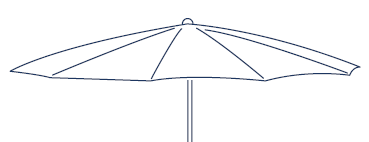We use cookies to make your experience better. To comply with the new e-Privacy directive, we need to ask for your consent to set the cookies. Learn more.
The Ultimate Patio Umbrella Guide – Find the right outdoor shade for you
Tired of struggling with difficult patio sets? Confused by all the options on the market?
Then read this definitive guide for choosing the best patio umbrella to buy in 2025.
Finding shade for your outdoor living space should be easy, so we’re here to help.
Unless you want to buy a new patio umbrella every year, you need to consider some important points:
• What type would work best in your space
• How sturdy and stable the base should be
• Whether the frame is durable, flexible or both
• What kind of fabric the canopy uses
We’ll cover all of these points in detail so that you can shop quickly and easily for outdoor shade that will serve you well.
Contents
Know your umbrellas - Patio umbrella or cantilever umbrella – which is the best?
What’s a cantilever? How is it different from an offset? Is a market patio umbrella better than a regular patio umbrella? Which is the best?
In this chapter, we’ll not only define these and more but also give you an easy way to make the right choice. Here’s a hint: SPA!
First, let’s explain the different types of shade you can choose for your backyard or deck.

Patio umbrella or market umbrella
A patio umbrella has a central pole, and a good patio umbrella has a mechanism that lets you tilt the shade when the sun is low on the horizon.
In size, it usually ranges from 6 to 13 feet and may come without a base.
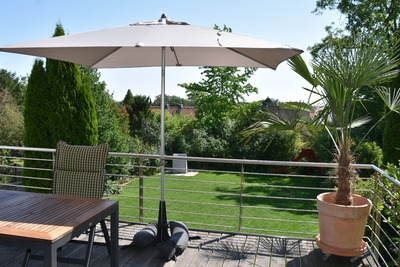
Pro tip:
The difference between market umbrellas and patio umbrellas is only in the name. Both are outdoor umbrellas with central poles, and they have the same functions and size range. So you might want to include “market umbrella”in your searches.
Cantilever umbrella or offset umbrella
A cantilever patio umbrella has its pole off to one side and works well to shade patio furniture. This type has to have a counterweight, so it comes with a base you can fill or pin down with weight.
A cantilever umbrella ranges from 9 to 13 feet in size.

Pro tip:
Offset umbrellas and cantilever umbrellas are the same thing with different names. Both have the pole on one side instead of directly beneath the umbrella. You may also see them referred to as “hanging canopy umbrellas” so look for that as well.
Half patio umbrella or Balcony umbrella?
A balcony umbrella is a smaller patio umbrella made especially for the balcony. A half umbrella is cut to fit on small balconies or patios.
Its shape often makes it possible to position against walls. Both are great for tight areas or small door shelters.
It ranges in size from 5 to 9 feet and often comes without a base or holder.
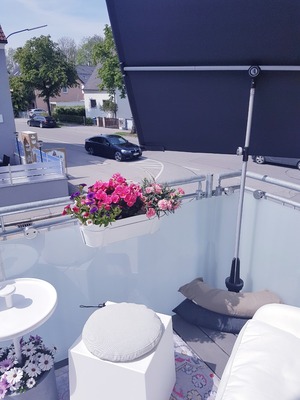
How to choose the right patio umbrella
Now that you know which is which, which is best for you?
Let’s dive into the SPA – Size, Placement, and Angle!
Or you can download our complete report so you avoid the 5 biggest mistake everybody is doing!

Size - what size of patio umbrella should I get?
This one is simple – how much shade do you want? Do you have a big pool area and want to escape the sun while hanging out with your friends?
Or do you just want a shady spot on your balcony where you can sit with a drink and a good book?
Well how big should your patio umbrella be? Check out quick guide below!

Pro tip: How big your patio umbrella should be depends on the size of your outdoor space that needs shade, but we recommend 8 feet for a small patio, 10 feet for most decks, and 11.5 feet for large areas.
Pool or large terrace
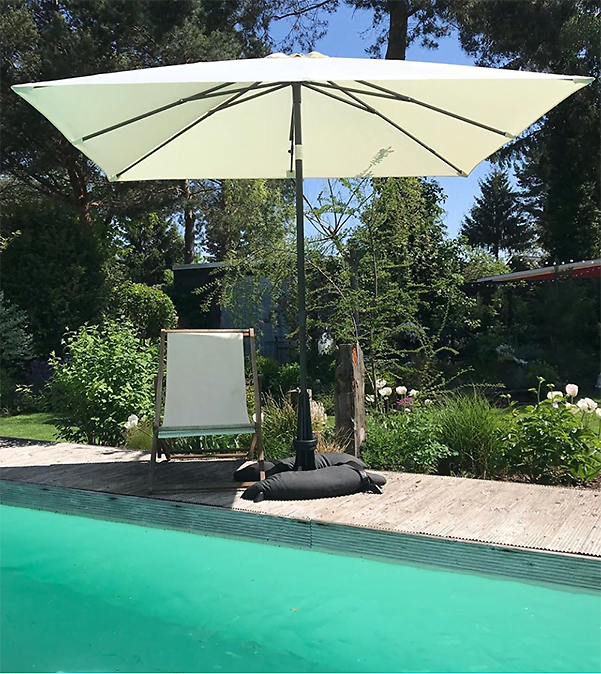
patio umbrella 2.8-3.5 m
Cantilever 3x3 or 3.5 m
Terrace with a table

patio umbrella 2.8-3.2 m
Cantilever 2.8x2.8 or 3 m
Balcony or a cafe table

patio umbrella max 2.8 m
Half patio umbrella 2.5 m
Sun lounger or a smaller spot
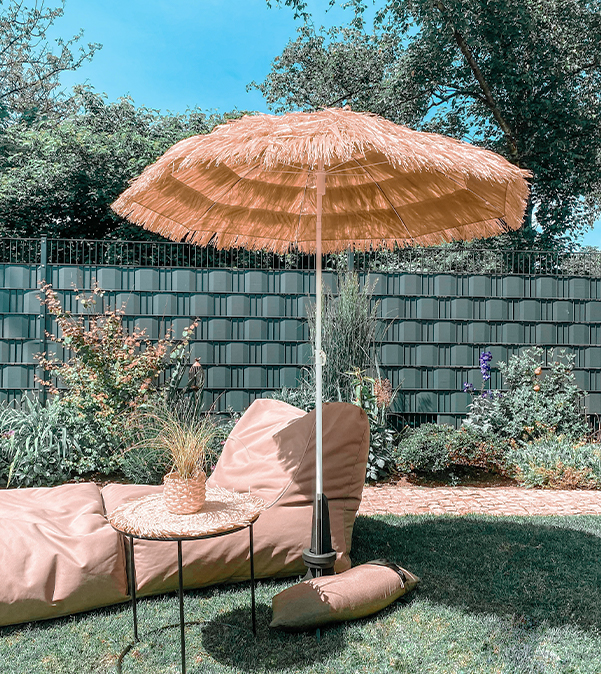
patio umbrella max 2.5 m
Half patio umbrella 2.5 m
A good rule of thumb: Get an umbrella 2-3 feet wider than the space you wish to shade.To learn more, you can read our dedicated guide on choosing the right patio umbrella size.
Placement
The biggest factor here is whether you want to move your patio umbrella to different areas or set it and forget it.
A cantilever patio umbrella with its offset canopy may limit your options, whereas most standard patio umbrellas can relocate freely.
Of course, the cantilever makes it easy to project shade over furniture such as reclining chairs or small tables.but it's impossible to move around.
The patio umbrella is more flexible, and with the right stand you can place the pole close to or directly through a table to shade it fully when the sun is at its peak.
|
I just want shade in one area. |
I need shade in different areas. |
|
An outdoor umbrella is the safe choice, however a cantilever is also a good choice. |
A patio umbrella is the best choice and offers the best value for money. |
Pro tip: Remember to factor in the wind. Cantilever umbrellas are more sensitive than patio umbrellas, so make sure you have enough weight if you live in a windy region.We recommend 220 lbs for most cantilever umbrellas.
Angle
Do you want to block bright morning sun, hot midday sun or sun in the evening as the shadows grow long? To choose the right umbrella, you need to think about where your shade will fall throughout the day.
If you want full shade in the morning or evening, a patio umbrella or cantilever umbrella with tilt would suit you best. For midday sun, a regular patio umbrella or half umbrella may be your most affordable choice.
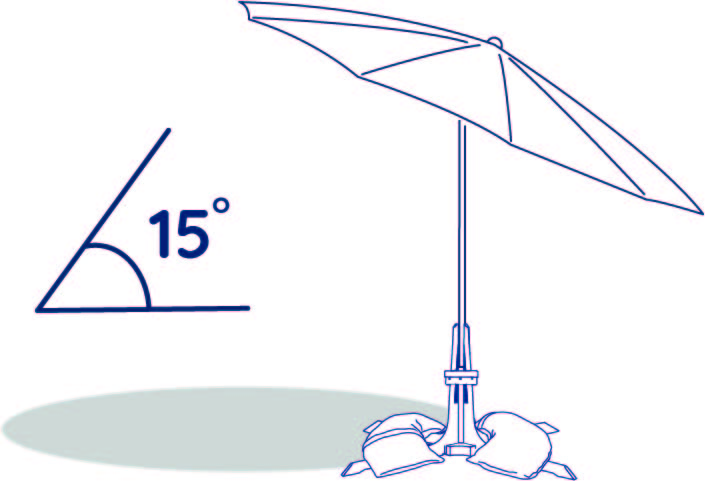
Pro tip: A patio umbrella with height and tilt adjustment increases your ability to block the sun when it’s low on the horizon.
Morning sun

|
For full shade, go for a patio or cantilever with a tilt function.
If you want a little sun in the morning, a regular patio umbrella would work well. |
Midday sun

|
A sturdy patio umbrella with high-quality fabric is your best choice.
A cantilever can also do the job but may cost more. |
Evening sun
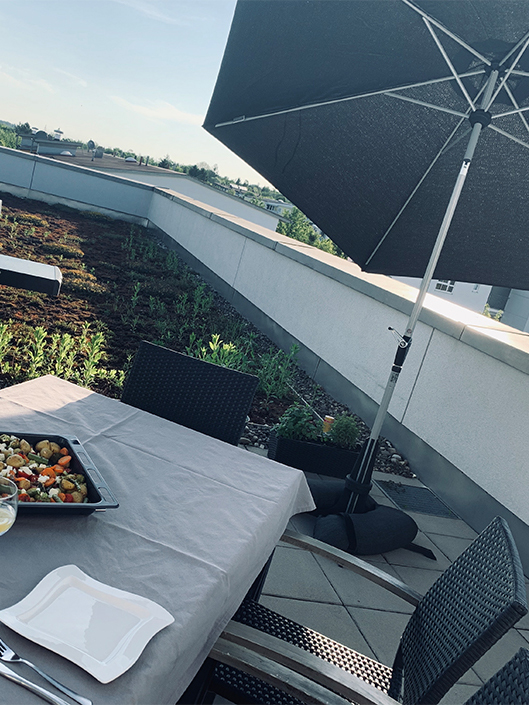
|
A patio umbrella with tilt and height adjustment is the cost-effective choice.
You can always explore cantilever options with height and tilt functions. |
Stability is in the base
The bottom of your patio umbrella is just as important as the top!
A good patio umbrella base will keep your patio umbrella from falling over or flying off – but which base to choose?
A great base will ease your fear of your patio umbrella crashing a nice picnic or fleeing across the yard. So let’s talk about how to keep it where it belongs.
Size and wind
The most important factor for finding the right base is to match its weight with the size of your patio umbrella. The second most important factor is to consider the wind in your region.
Freestanding or with a table?
A umbrella fitted to your table requires a lighter base than a standalone umbrella, but you can move a standalone base more easily.
For patio umbrella bases used with tables, we recommend 17.5-35 lbs.
For standalone patio umbrellas, we recommend between 35-45 lbs
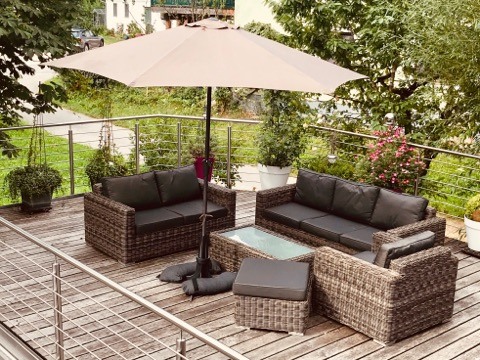
Pro tip: The type of umbrella you have can influence the base you need. A cantilever umbrella often comes with a base that you can fill with sand for stability or a cross that you can weigh down with sandbags. A patio umbrella may need you to buy a base separately, so you should make sure the base fits your umbrella pole and has enough weight to hold it. You can read our patio umbrella base guide for more information.
How much wind can a patio umbrella take?
The weight of your patio umbrella base determines how much wind your patio umbrella can take.
Summer winds can average around 8.1 mph, and patio umbrellas with heavy bases can withstand 20-mph gusts.
Of course, that number drops if your umbrella is tilted because then it catches the wind like a sail.
Pro tip: Patio umbrellas in windy places need 1) durable materials, 2) sturdy yet flexible construction and 3) secure bases to keep them anchored. Make sure you pay attention to these three points before you start looking at fabric colours and patterns.
patio umbrella stand how heavy?
To find the right amount to weigh down your patio umbrella properly, take a look at the table:
If you need more information, you can read our guide on how heavy your patio umbrella base should be and how to keep patio umbrellas from flying away or spinning.

Make sure to find the right weight for your base, as this is key to keeping your patio umbrella upright in your own yard. If you want to tilt your patio umbrella, always add a little extra weight (such as Baser’s sandbags) to be on the safe side.
What materials should you choose - Strength vs. flexibility
Are the materials important? Definitely! You need to think about what the pole and mechanisms are made of as well as what colour you want the umbrella to be. This part is pretty easy, though.
Aluminium? Steel? Fibreglass? What’s the best material for your patio umbrella frame?
Let’s discuss how to spot good and bad quality.
The key is to find a sturdy and durable frame material that will last for a long time outdoors.
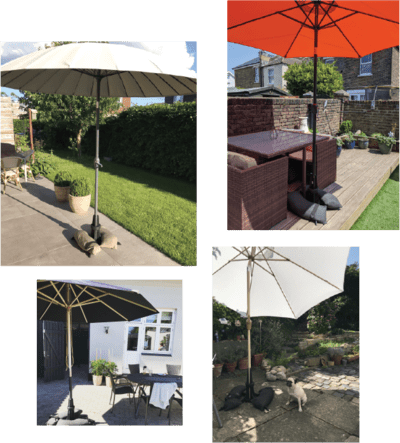
Fibreglass vs. aluminium
A fibreglass patio umbrella frame is made from molded plastics reinforced with fibreglass. This combination creates a strong yet flexible material, making it ideal for patio umbrellas. Like aluminium, it’ll never rust. Unlike aluminium, it has a good weight-to-strength ratio.
|
Fibreglass |
Aluminium |
|
|
Rust |
No |
No |
|
Strength |
Medium |
Medium |
|
Weight |
Medium |
Light |
|
Flexibility |
Yes |
No |
Both aluminium and fibreglass frames are rust-free and lightweight compared to steel, making both materials a good choice for your next patio umbrella.
Want a flexible frame?
What’s the best material for a patio umbrella frame?
The best frame for your patio umbrella should be flexible, durable, rust-free and low maintenance. Fibreglass and aluminium are ideal candidates, especially fibreglass because it flexes in the wind. Wood umbrella frames are beautiful and offer fine strength but are expensive. Steel is heavy and can rust.
Pro tip: Check to see whether you can get spare parts for your frame. A more expensive patio umbrella pays off in the long run if you can replace its parts instead of buying a cheap new patio umbrella every two years.
What features to look for when buying a umbrella
Some features are a must.
Others are simply nice to have (Spoiler alert tilt and height adjustment are key).
Which is which? Let’s dive in.
Tilt and height adjustment – must have
A tilt mechanism and height adjustment are the most important functions your patio umbrella should have.
Adjusting the height and tilt helps you get the shade when and where you want it, even when the sun is low.
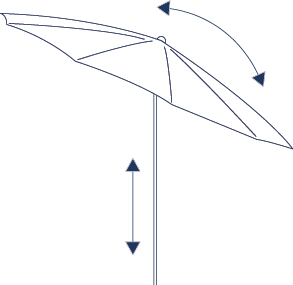
Pro tip: Which is better, push to tilt or turn to tilt? We suggest avoiding unnecessary mechanisms that can break. Also keep in mind that turn-to-tilt patio umbrellas are often limited in their height adjustment, so we recommend the push-to-tilt type.
Crank, push or pull?
Most patio umbrellas open in one of three ways – by cranking into place, by pushing like a handheld umbrella, or by pulling a cord and setting a pin. This table outlines the advantages and disadvantages of each.
Crank
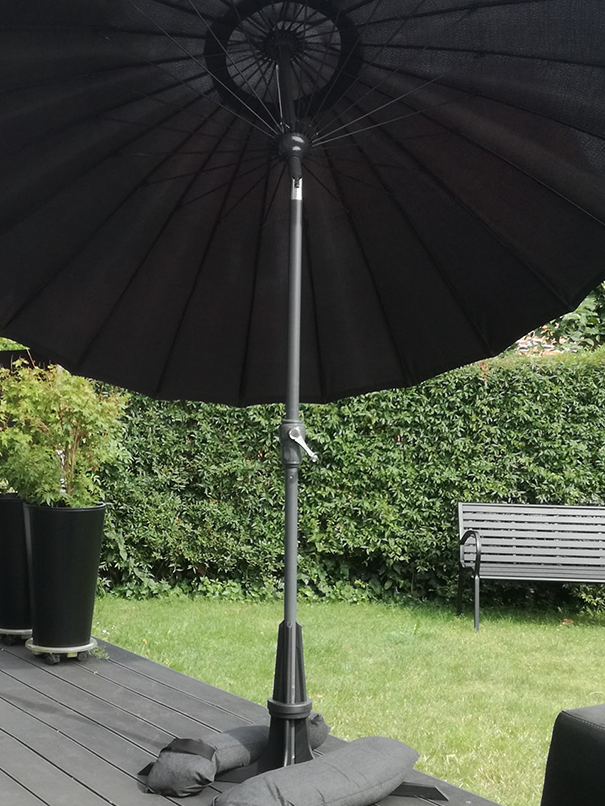
|
How to open: Open: Turn clockwise until fully extended. Close: Turn anti-clockwise until fully folded.
Advantages: Straightforward to use and known to many
Disadvantages: No height adjustment Mechanism is difficult to repair |
Push
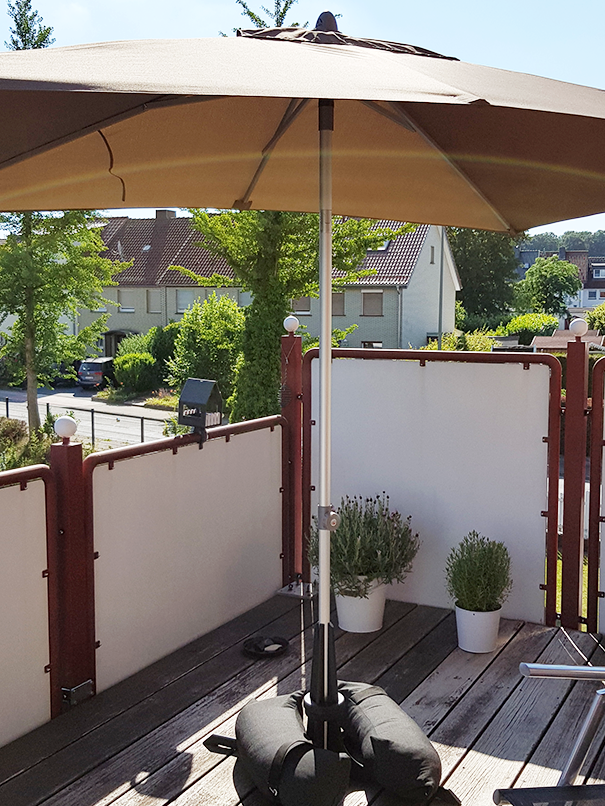
|
How to open: Open: Push up until it clicks into place. Close: Click the release and lower.
Advantages: Simple, durable, and allows for height adjustment
Disadvantages: Requires more strength than crank |
Pull

|
How to open: Open: Pull the cord and set the locking pin. Close: Remove the pin and lower.
Advantages: Traditional, familiar to most consumers
Disadvantages: Requires strength, cord curls up. |
Lights?
The newest trend in patio furniture eases the transition from indoors to outdoors, allowing you to bring the comfort of your home to your yard.
Buying a patio umbrella with lights means deciding on solar power or external power. Solar power is the most sustainable, but external will give you more powerful and longer-lasting light.
You may also want to consider the warmth of the light and its structure. For a cozy feel, we recommend warm light, between 40-300 lumens, but you can always go higher if you prefer safety to ambiance. And while you can get umbrellas with built-in lights, having them as an attachment could make them easier to fix if they break.

When shopping for a patio umbrella, you need to look for strong, rust-free and durable materials such as aluminium or fibreglass for the frame. The most important features of your frame are tilt and height adjustment. To open your umbrella, we recommend the push style.
Fabric is more important than you think
What’s a good fabric for a patio umbrella? You need to know how to avoid thin material that rips and fades before you’re ready to buy again.
Manufacturers pile on numbers and industry terms to tell you about their products, but you need to know what they mean to make the right choice. What’s the best material for your canopy?
The best fabric for your patio umbrella is substantial, with a minimum of 190 g/m2. It should also be weather- and stain-resistant. The fabric should have a minimum colourfast rating of 6, be certified nontoxic and have a UV protection standard such as UV-801.

Weight
You know right away when you touch a fabric if it will last – heavy, rough denim can exist for decades, while light, delicate silk may expire in a season. But how can you get the same certainty online?
The answer lies in the numbers. Fabric weights are measured in ounces per square yard (oz/yd2). Low-quality umbrella materials generally fall in the 2.95-4.42 oz/yd2 range, medium quality covers 4.42-5.31, and high quality goes from 5.31 to 7.37..

Pro tip: If you can’t find the weight anywhere on the site you’re shopping, then you’re probably looking at low quality. A substantial material weighing in at more than 6.5 oz/yd2 will reduce your need to buy a new umbrella every few seasons.
Type
Patio umbrellas fabric comes in three types – acrylic, polyester and olefin. These vary in durability as well as price.
What makes the best Patio umbrellas fabric? A material that is thick and solution dyed. Olefin and acrylic are the top performing fabrics, with high fade resistance and UV protection. They’re also stain- and mildew-resistant. Polyester is lower quality, often only coloured on the surface, so it fades quicker and is less durable.
This table lays out the differences.
Polyester

|
Feel: Stiff like plastic
Price: Low
Fade resistance: Low
Dyeing process: Piece dyeing (surface) |
Olefin
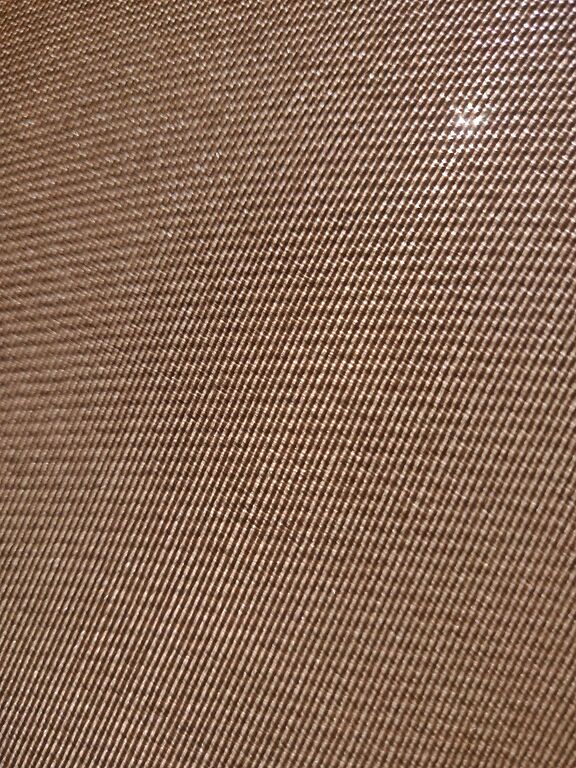
|
Feel: Heavy yet smooth
Price: Medium to high
Fade resistance: Medium to high
Dyeing process: Solution dyed (full colored) |
Acrylic
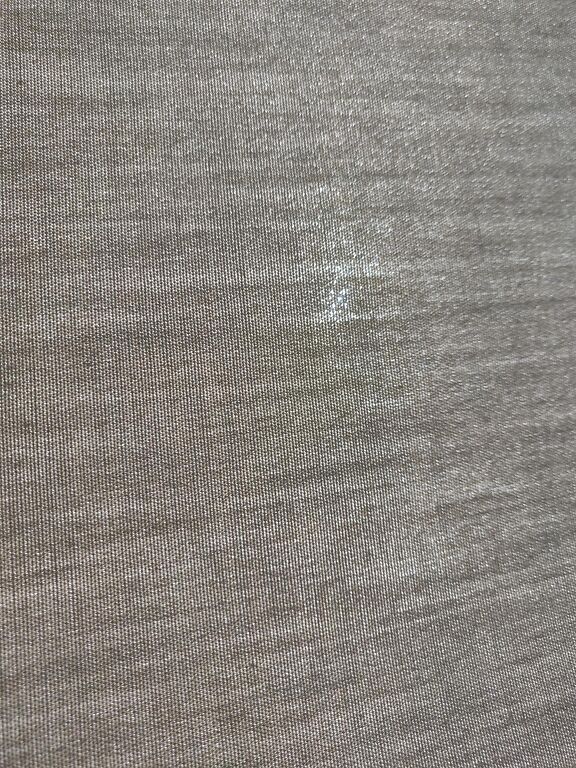
|
Feel: Rough and sturdy
Price: Medium to high
Fade resistance: Medium to high
Dyeing process: Solution dyed (full colored) |
Fade resistance
When you read about patio umbrellas, you’ll often see “certified UV protection” or “guaranteed colour fastness” showing up. But what do they mean?
A fade-resistant patio umbrella has a rating of more than 6 on the blue wool scale, which ranges from 1 to 8.
A grade of 7 or 8 can be guaranteed for 18 months of sunlight exposure before any fading becomes visible.
A grade of 4 or 5 can see fading within 35 days, check the video.
Here’s a quick guide on how the scale works.
|
Grade |
Time |
Changes |
|
1 to 5 |
Within 35 days |
In just a few weeks, you’ll see fading and lines, even if you use a cover. |
|
6 |
Within 56 days |
Usually you’ll be near the end of the season before you notice colour loss. |
|
7 |
More than 122 days |
Usually you’ll be near the start of the 2nd season before you notice colour loss. |
|
8 |
More than 548 days |
It’ll take at least a year and a half of direct sunlight before you see any fading. |
"The above is Polyester fabric grade 5 with faded lines after 45 days. Make sure to get a quality fabric for less fading and higher protection from UV rays."
Pro tip: Although light colours stay true a little longer than dark colours, the difference is small, so you can choose whatever colour you like best. Neutrals such as brown, beige and grey are popular, along with a variety of blues.
Dyeing process
How the fabric for your patio umbrella is produced has a direct effect on how well the colour will hold.
The two most common ways to colour patio umbrellas are solution dyeing and piece dyeing.
Fortunately, the difference between the results of these two processes is really obvious.
A piece-dyed fabric is coloured only on the surface, like a radish.
A solution-dyed fabric is coloured all the way to the core, like a carrot.
Only dyeing the surface means that piece-dyed materials lose their colour much faster than solution-dyed.
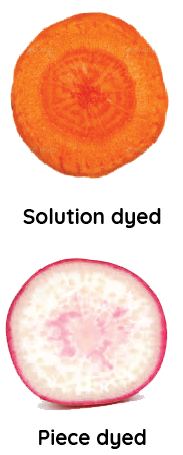
Pro tip: If the site doesn’t state how the fabric is dyed, it’s probably piece-dyed and will lose its colour fast. Solution-dyed materials keep their colour stronger for far longer than piece-dyed.
UV protection
It takes more than blocking the light to block the sun’s UV rays, and some patio umbrellas block no UV at all. Fortunately, many vendors offer UV ratings for their products, but what’s a good rating?
The best patio umbrella for UV protection has an ultraviolet protection factor (UPF) higher than 50 and is backed with a UV standard. A UPF of 50 blocks 97% of all UV rays, and UV 801 offers the maximum UV protection.
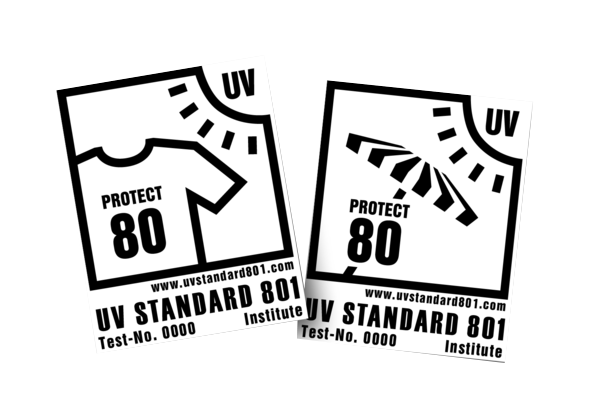
Pro tip: If you’re unsure about how much UV the patio umbrella blocks, then choose black. Darker colours absorb more UV light to protect you better. You can choose any colour you wish when your patio umbrella fabric has the UV 801 standard.

Pick a solution-dyed fabric with a minimum thickness of 6.5 oz/yd2. We recommend olefin or acrylic for your new patio umbrella.
Recap
Whew! That was a lot! So we collected 5 quick tips to help you find the perfect patio umbrella without reading the whole guide again.
We know finding the best patio umbrella can be a struggle, so here’s an easy rundown of the most important points to consider.
You found the best patio umbrella if it:
Casts the proper amount of shade where you need it
Has height adjustment and tilt functions
Is easy to open and close
Has a strong, flexible frame
Pro tip: Help improve our world by investing in sustainability as well. Buy locally when you can, and make sure the materials are durable, repairable, and recyclable whenever possible.
 FAST AND FREE SHIPPING
FAST AND FREE SHIPPING
 ONE OF A KIND PATIO UMBRELLA
ONE OF A KIND PATIO UMBRELLA
 BEST WARRANTY AND SERVICE IN THE MARKET
BEST WARRANTY AND SERVICE IN THE MARKET 




